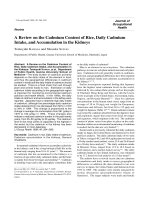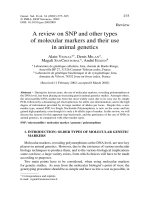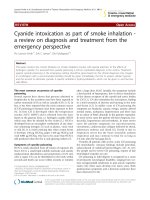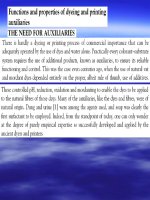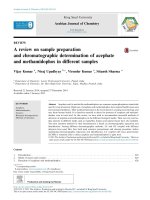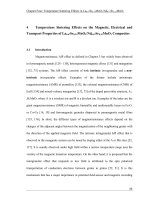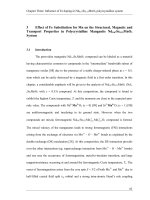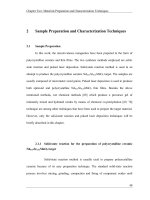A review on natural fibers: Extraction process and properties of grass fibers
Bạn đang xem bản rút gọn của tài liệu. Xem và tải ngay bản đầy đủ của tài liệu tại đây (524.48 KB, 8 trang )
International Journal of Mechanical Engineering and Technology (IJMET)
Volume 11, Issue 1, January 2020, pp. 84-91, Article ID: IJMET_11_01_009
Available online at />ISSN Print: 0976-6340 and ISSN Online: 0976-6359
© IAEME Publication
A REVIEW ON NATURAL FIBERS:
EXTRACTION PROCESS AND PROPERTIES OF
GRASS FIBERS
IP Lokantara
Doctoral Study Program, Faculty of Engineering, Udayana University,
Denpasar, Bali, Indonesia
Mechanical Engineering Department, Faculty of Engineering, Udayana University,
Denpasar, Bali, Indonesia
NPG Suardana, IW Surata, INS Winaya
Mechanical Engineering Department, Faculty of Engineering, Udayana University,
Denpasar, Bali, Indonesia
ABSTRACT
Today, research on natural fibers as composite reinforcement aims to study the
extraction process, physical properties, chemical properties and mechanical
properties of natural fiber. Natural fiber attracts researchers because it has high
specific strength, light density, low cost, good mechanical properties, nonabrasive,
environmentally friendly and biodegradable in nature. A brief review has been carried
out for using abundant natural fibers available in Indonesia. This paper present a
review of Mendong grass, Snake grass, Kusha grass, Arundo donax L, Sansevieria
ehrenbergii, Sansevieria cylindrica, Elephant grass, Napier grass, Sansevieria
trifasciata, Broom grass, Sisal, Corn husks, and Belulang grass.
Keywords: grass fiber, extraction process, chemical properties, physical properties,
mechanical properties.
Cite this Article: IP Lokantara, NPG Suardana, IW Surata, INS Winaya, A Review
on Natural Fibers: Extraction Process and Properties of Grass Fibers. International
Journal of Mechanical Engineering and Technology 11(1), 2020, pp. 84-91.
/>
1. INTRODUCTION
In the last ten years, the use of natural fiber-reinforced composites in the engineering field has
increased due to abundant availability, low processing costs, lightweight, good mechanical
properties, nonabrasive, eco-environment friendly, easy to decompose in nature [1]. Natural
fibers are widely used as composite reinforcement in the marine fields, the automotive,
handicraft and household appliances [2,3]. Synthetic fibers such as fiberglass, aramid, and
nylon have been used as composite reinforcements for more than fifteen years. This synthetic
fiber has many disadvantages, especially from environmental aspects such as long-time
/>
84
A Review on Natural Fibers: Extraction Process and Properties of Grass Fibers
decomposed in nature, expensive, causes irritation and is toxic when burned [4]. Many
researchers have conducted research on natural fibers as an alternative to synthetic fibers by
improving the physical and mechanical properties of composite materials [5]. Natural fibers
generally extracted from bark, stem, fruit, leaf, and roots of the plant [6-9]. The chemical
structure of natural fiber cellulose depends on the origin, age parts (roots, fruits, stems, bark,
leaves) taken from plants. The cellulose element in the fiber is covered by several noncellulose elements such as hemicellulose, lignin, wax. Some type of natural fiber such as
mendong grass [10], Napier grass [11,12], Elephant grass [13], Snake grass [14], Sansevieria
ehrenbergii [15], Wild cane grass [16], Broom grass [17], Kusha grass [18], Sisal [19,20],
Sansevieria cylindrica [21], Arundo donax L. [22], Sansevieria trifasciata [23], Corn husk
[24] has been investigated as an reinforcement in polymer composite. However, research on
new natural fibers still needs to be continued to be investigated to increase alternative
fiberglass substitutes as reinforcing polymer composites. Indonesia as one of the tropical
countries has diverse plants that have the potential to produce natural fibers, one of which is
from the type of grass plants, namely belulang grass (Eleusine indica). In this paper, we will
describe the extraction process, physical properties, chemical properties and mechanical
properties of various types of grass including belulang grass.
2. EXTRACTION PROCESS OF GRASS FIBERS
The fiber extraction process is the process of separating fibers from plant parts (stems, fruits,
leaves, bark, and roots). In general, the extraction process that is often used is the mechanical
extraction process and the retting process. After extraction of fibers by any of these methods,
all extracted fibers are washed away before drying. Proper drying is important as the moisture
content in fiber affects fiber quality. Artificial drying results in higher-grade fiber than sun
drying. The fibers were dried under a shade to avoid beaching by direct sunlight. Dry fibers
and then combed, sorted into different grades and packed into bales. The mechanical
extraction process is carried out mechanically using human or machine power. The part of the
plant to be separated by fibers is inserted into a corticator machine consisting of two grinding
gears that are driven by human or machine power. The gears will grind the plant parts to
obtain fiber. The resulting fiber is still dirty, needs to be rinsed with clean water [19]. The
water retting process is done by soaking the stems, bark, leaves, seeds, the fruit of the plant in
water for a certain period so that the fibers are released, then the fibers are cleaned with clean
water and dried. Table 1 below summarizes the process of extracting fiber from several types
of grass fiber.
Table 1 Grass fibers extraction process
Fibers
Mendong grass
Snake grass
Kusha grass
Arundo donax L
Sansevieria ehrenbergii
Sansevieria cylindrica
Elephant grass
Extraction process
Water retting. Mendong straw was pounded
repeatedly and then cleaned using water. Then, fibers
were soaked in water for 7 days. Fibers were
retrieved, cleaned, and allowed to dry wind
Water retting. The fiber is soaked in water for 4 days,
then the fiber is separated manually, air-dried for 8
hours, oven 60 minutes at 160°C.
Water retting 28 days and dried at ambient
temperature for 7 days.
The mechanical process using decorticator
The mechanical process using decorticator
Mechanical process decortication, the fiber washed
with water then dried in the sun for 24 hours
The culms of elephant grass were dried in shade for a
/>
85
Reference
[10]
[14]
[18]
[22]
[15]
[21]
[13]
IP Lokantara, NPG Suardana, IW Surata, INS Winaya
Napier grass
Sansevieria trifasciata
Broom grass
Corn husks
Sisal
Belulang grass
period of one week. They were soaked in water for a
period of about 10 days.
Mechanical, grass stalks are ground with a roller,
then water retting for 7 days, dried in the sun for 7
days
Water retting for 5 days and using the hand
scrutching method, then washed with water and dried
in the sun.
Water retting for 4 hours, extraction of fiber
manually, then the fibers are dried 7 days, oven 70°C
for 2 hours
Water retting, corn husks soaked in water for 16
days, extraction of fiber using a plastic comb, then
the fibers are naturally air-dried
Water retting followed by scraping and mechanical
using decorticators
Water retting 8 days, dried in at ambient condition
for 24 hours. Separation of fibers by a mechanical
process using a plastic comb
[12]
[23]
[17]
[24]
[19]
Present
work
From table 1 above, the process of extracting grass fibers varies. Grass fiber extraction
methods can be grouped into 3 parts: water retting process, mechanical process, the
combination of mechanical processes with water retting. The most extraction process of grass
fiber uses water retting because the process is very simple, easy to do, cheap and good result.
Soaking time in the water retting process depends on the type of fiber, varying from 4 hours
(Grass broom) to 28 days (Kusha grass). The average soaking time is 7 days. Some fibers can
be separated during the water retting process, some other fibers must be air-dried at room
temperature for several days. Drying process the separated fiber can be grouped into 3 ways:
drying under the sun, natural air dried, and oven.
3. CHEMICAL PROPERTIES
Natural fibers in general consist of layers of lignin, hemicellulose, cellulose. The outermost
layer of fiber generally consists of a layer of lignin, the inner layer of the hemicellulose and
the innermost cellulose. Cellulose is the most important part of natural fiber because cellulose
has good adhesion properties with a matrix in the composite's production process. Fibers that
have a high percentage of cellulose tend to have good mechanical properties. Table 2 presents
the contents of cellulose, hemicellulose, and lignin from natural fibers of grass type. Also
displayed is the moisture content of each fiber. Table 2 showed that some fibers have not been
tested to determine chemical properties, including broom grass, Sansevieria trifasciata,
elephant grass, snake grass. This gives an opportunity to carry out further research. The
cellulose content of grass fiber varies from the smallest 43.2 (Arundo donax L) and the
greatest value is 80 (Sansevieria ehrenbergii).
The hemicellulose content varies from the smallest of 10 (sisal) to the highest of 33.7
(Corn husk). Lignin content varies from the smallest of 3.44 (Mendong grass) to the greatest
value of 21.63 (Napier grass). The moisture of each fiber varies from 6.08 (Sansevieria
cylindrica) to 11,961 (Corn husk)
/>
86
A Review on Natural Fibers: Extraction Process and Properties of Grass Fibers
Table 2 Chemical properties of grass fibers
Fibers
Cellulose
Hemicellulose
Lignin
Mendong grass
Snake grass
Kusha grass
Arundo donax L
Sansevieria ehrengergii
Sansevieria cylindrica
Elephant grass
Napier grass
Sansevieria trifasciata
Broom grass
Corn husk
Sisal
Belulang grass
72.14
70.58
43.2
80
79.7
47.12
46.15
78
45.8
20.2
20.5
11.25
10.13
31.27
33.7
10
32.29
3.44
14.35
17.2
7.8
3.8
21.63
3.92
8
7
Moisture
(wt %)
8.01
10.55
6.08
11.961
11
11.36
References
[10]
[14]
[18]
[22]
[15]
[21]
[13]
[12]
[23]
[17]
[24]
[20]
Present work
4. PHYSICAL PROPERTIES
Natural fiber has advantages compared to glass fiber, one of which is lighter density. Each
fiber has a different density. The measurement of fiber density is measured in several ways.
Some researchers use the Truong method [26] to determine the density of fibers. Fiber density
is measured with a pycnometer using the Archimedes principle, where the volume of fiber
dipped in a liquid is equal to the volume of spilled liquid.
ρf =
(
((
)
) (
)
ρf is the density of the fiber, ρl the density of the liquid in the pycnometer, m1 mass of the
empty pycnometer, m2 of the pycnometer mass filled with fiber, m3 mass of the pycnometer
filled with liquid, m4 mass of the pycnometer filled with liquid and fiber. Fiber density is used
to determine the weight fraction and fiber volume fraction in composite production. Besides
density, an important physical property is fiber diameter. Fiber diameter is needed to
determine the tensile strength of single fiber for each grass fiber. The diameter of grass fibers
varies greatly because of the irregular cross-section shape of the fibers. The diameter of the
fiber is measured by microphotographs with micrometers (µm).
Table 3 Physical properties of grass fibers
Fibers
Mendong grass
Snake grass
Kusha grass
Arundo donax L
Sansevieria ehrengergii
Sansevieria cylindrica
Elephant grass
Napier grass
Sansevieria trifasciata
Broom grass
Corn husks
Sisal
Belulang grass
Density(gr/cm3)
0.892
0.887
1.1025
1.168
0.887
0.915
0.817
0.358
1.4147
0.864
0.34
0.76
1.2138
/>
87
Diameter (µm)
338 ± 56
45-250
70-100
20-250
70-400
150-550
80-120
185-520
0.186
122-135
81-178
References
[10]
[14]
[18]
[22]
[15]
[21]
[13]
[12]
[23]
[17]
[24]
[20]
Present work
IP Lokantara, NPG Suardana, IW Surata, INS Winaya
Table 3 contains a comparison of the density and diameter of each grass fiber. From table
3 it is shown that the density of grass fiber is still smaller than the density of glass fiber, very
suitable for light product applications. The smallest density of corn husk fiber is 0.34 gr/cm3
and the highest density of Sansevieria trifasciata is 1.4147 gr/cm3. There are 30% of fibers
whose density is above 1 gr/cm3, one of which is belulang grass. The diameter of grass fiber
also varies from the smallest namely corn husk of 0.186 µm to the largest namely elephant
grass of 400 µm. The fiber diameter value is very useful to determine the surface area and the
tensile strength of a single fiber.
5. MECHANICAL PROPERTIES
The tensile test is one of the most widely used material tests. The tensile test is testing of test
material by pulling the material until it breaks.
F
A0
σ is the tensile strength (Mpa) value, F is the force used to pull the fiber (N), Ao is the
cross-sectional area of the fiber (mm2).
Table 4 Mechanical properties of grass fibers
Fibers
Mendong grass
Snake grass
Kusha grass
Arundo donax L
Sansevieria ehrenbergii
Sansevieria cylindrica
Elephant grass
Napier grass
Sansevieria trifasciata
Broom grass
Corn husks
Sisal
Belulang grass
Tensile
Strength
(Mpa)
452 ± 47
278.82
248
50-585
658
185
88.4
297.58
160.49 ± 17.2
536-640
116.5-445.1
Young’s
modulus
[GPa]
17.4 ± 3.9
9.71
9.4
2.5-7.5
7.6
7.4
13.15
18.28
4.57 ± 0.54
9.4-22
0.97-3.68
Elongation
at break
(%)
2.87
3.24
2.8-21.7
10
2.5
0.99
2.87
21.08 ± 2.86
3-7
0.98-1.7
References
[10]
[14]
[18]
[22]
[15]
[21]
[13]
[11]
[23]
[17]
[24]
[20]
Present work
The purpose of this tensile test is to determine the tensile strength of the material. The
higher the tensile strength value of a material, the stronger the material, and vice versa. The
value of the mechanical properties of grass fiber can be seen in table 4.
From table 4 above, Kusha grass and Sansevieria trifasciata need research to determine its
mechanical properties. The tensile strength value of grass fiber varies from 88.4 MPa (Napier
grass) to 640 MPa (Sisal). Young's modulus also varies from 0.97 GPa (Belulang grass) to
18.28 Gpa (Broom grass). Elongation at break also varies from 0.98% (Belulang grass) to
21.08% (Corn husks). Mechanical strength is a combination of the value of tensile strength,
the value of young modulus, and the value of elongation at break. The value of mechanical
strength of materials used by designers to design a product in the industry
6. CONCLUSION
EXTRACTION Process, classified into three types, water retting, mechanical process, and a
combination of mechanical process and water retting. The soaking time in the water retting
/>
88
A Review on Natural Fibers: Extraction Process and Properties of Grass Fibers
process varies from 4 hours to 28 days. Drying the separated fiber by three ways: drying
under the sun, natural air dried, and oven.
Chemical Properties, the cellulose content of grass fiber varies from the smallest 43.2
(Arundo donax L) and the greatest value is 80 (Sansevieria ehrengergii). The cellulose
content varies from the smallest of 10 (Sisal) to the highest of 33.7 (Corn husks). Lignin
content varies from the smallest of 3.44 (Mendong grass) to the greatest value of 21.63
(Napier grass). Moisture of each fiber varies from 6.08 (Sansevieria cylindrica) to 11,961
(corn husks)
Physical Properties, the density of grass fiber is still smaller than the density of glass fiber,
very suitable for light product applications. the smallest density of corn husk fiber is 0.34
gr/cm3 and the highest density of Sansevieria trifasciata is 1.4147 gr/cm3. there are 30%
fibers whose density is above 1 gr/cm3, one of which is belulang grass. the diameter of grass
fiber also varies from the smallest namely corn husks of 0.186 µm to the largest namely
elephant grass of 400 µm. the fiber diameter value is very useful to determine the surface area
and the tensile strength of a single fibers.
Mechanical Properties, the tensile strength value of grass fiber varies from 88.4 MPa
(Napier grass) to 640 MPa (Sisal). Young's modulus also varies from 0.97 GPa (Belulang
grass) to 18.28 Gpa (Broom grass). Elongation at break also varies from 0.98% (Belulang
grass) to 21.08% (Corn husks). Mechanical strength is a combination of the value of tensile
strength, the value of young modulus, and the value of elongation at break. The value of
mechanical strength of materials used by designers to design a product in the industry
ACKNOWLEDGMENT
Thanks to Prof. NPG Suardana, Prof. I Wayan Surata, Prof. I Nyoman Suprapta Winaya, who
guided this research
REFERENCES
[1]
Jawaid, M., and Abdul Khalil, H. P. S, Cellulosic/synthetic fiber reinforced polymer
hybrid composites: A review. Carbohydrate Polymer. 86, 2011, pp. 1-18.
[2]
Satyanarayana, K. G, Guimaraes. J. L and Wypych. F, Studies on lingo cellulosic fibers of
Brazil. Part I: Source, production, morphology, properties, and applications, Composites
Part A, 38, 2007, pp. 1694–1709.
[3]
Malkapuram, R., Kumar. V and Yuvraj. S. N, Recent development in natural fibre
reinforced polypropylene composites, Journal Reinf. Plast. Compos. 28, 2009, pp. 1169–
1189.
[4]
L. Sanchez Nacher, J. E. Crespo Amoros, M. D. Salvador Moya and J. Lopez Martinez,
Mechanical properties of polyester resins in saline water environments, Int. J. Polym.
Anal. Charact. 12(5), 2007, pp. 373–390.
[5]
Thakur. V. K, Singha. S.A and Mehta. I.K, Renewable resource-based green polymer
composites: Analysis and characterization, Int. J. Polym. Anal. Charact. 15, 2010, pp.
137-148.
[6]
M.R.Ishak, Z.Leman, S.M. Sapuan A, M. M. Edeerozey and I. S. Othman, and Nmegbu,
Mechanical Properties of kenaf bast and core fiber reinforced unsaturated polyester
composites, IOP Conf. Series: Materials Science and Engineering, 11, 2010, pp. 1-6, 2010
[7]
Mayandi. K, Rajini. N, Pitchipoo. P, Winowlin Jappes. J. T and Varada Rajulu. A
I.A.A.C., Extraction, and characterization of new natural lingo cellulosic fiber Cyperus
pangorei. Int.J. Polym. Anal. Charact, 21, 2016, pp. 175–183.
/>
89
IP Lokantara, NPG Suardana, IW Surata, INS Winaya
[8]
Mahato, D. N, Prasad, R.N and Mathur. B.K, Surface Morphological, band, and lattice
structural studies of cellulosic fiber coir under mercerization by ESCA, IR and XRD
techniques, Indian Journal of Pure & Applied Physics, 47, 2009, pp. 643-647.
[9]
Hassan, M. M., Islam. M.R, and Khan. M.A, Influence of additives on the performance of
photographed jute yarn with 3- (trimethoxysilyl) propyl methacrylate, Int. J. Polym. Anal.
Charact, 10(3), 2005, pp. 179–194.
[10]
Heru Suryanto, Eko Marsyahyo, Yudy Surya Irawan & Rudy Soenoko, Morphology,
Structure, and Mechanical Properties of Natural Cellulose Fiber from Mendong Grass
(Fimbristylis globulosa), Journal of Natural Fibers, 11(4), 2014, pp.333-345.
[11]
Haameem J.A, M., M. S. Abdul Majid, M. Afendi, H. F. A. Marzuki, I. Fahmi, and A. G.
Gibson. Mechanical Properties of Napier Grass Fibre/Polyester Composites, Composite
Structures, 136 (2), 2016, pp. 1-10.
[12]
Kommula, V.P., Reddy, K.O., Shukla, M., Marwala, T., Reddy, E.V.S., Rajulu, A.V.
2016. Extraction, modification, and characterization of natural lignocellulosic fiber strands
from Napier grass. International Journal of Polymer Analysis and Characterization,
21(1), 2016, pp.18-28
[13]
Rao, K. Murali Mohan, A. V. Ratna Prasad, M. N. V. Ranga Babu, K. Mohan Rao, and A.
V. S. S. K. S. Gupta. Tensile Properties of Elephant Grass Fiber Reinforced Polyester
Composites, Journal of Materials Science, 42 (9), 2007, pp. 3266-72.
[14]
Sathishkumar, T, P. Navaneethakrishnan, S. Shankar, and R. Rajasekar. Mechanical
Properties and Water Absorption of Short Snake Grass Fiber Reinforced Isophthalic
Polyester Composites, Fibers and Polymers, 15 (9), 2014, pp. 1927-34.
[15]
Sathishkumar, T.P., Navaneethakrishnan, P., Shankar, S., and Rajasekar, R.
Characterization of new cellulose sansevieria ehrenbergii fibers for polymer composites.
Composite Interfaces, 20(8), 2013, pp. 575-593.
[16]
A. V. Ratna Prasad, K. Mohana Rao, A. V. S. S. K. S. Gupta, B. V. Reddy , A Study On
flexural Properties Of Wildcane Grass fiber-Reinforced Polyester Composites, J Mater
Sci, 46, 2011, pp. 2627–2634.
[17]
Ramanaiah, K., Ratna Prasad, A.V., dan Hema Chandra Reddy, K., Thermal And
Mechanical Properties Of Waste Grass Broom Fiber-Reinforced Polyester Composites.
Materials & Design, 40, 2012, pp. 103-108.
[18]
A. N. Balaji, M. K. V. Karthikeyan & V. Vignesh, Characterization of New Natural
Cellulosic Fiber From Kusha Grass, Int. J.Polym. Anal. Charact, 21, 2016, pp. 29-39.
[19]
Ibrahim, I.D., Jamiru, T., Sadiku, R.E., Kupolati, W.K., dan Agwuncha, S.C., Dependency
of the Mechanical Properties of Sisal Fiber Reinforced Recycled Polypropylene
Composites on Fiber Surface Treatment, Fiber Content, and Nanoclay, J Polym Enviro,
2016.
[20]
Li Y, Mai Y-W, and Ye L. Sisal fiber and its composites: a review of recent
developments. Compos Sci Technol, 60, 2000, pp.2037–2055.
[21]
Sreenivasan, V.S., Somasundaram, S., Ravindran, D., Manikandan, V., dan
Narayanasamy, R. Microstructural, Physico-chemical and mechanical characterization of
Sansevieria cylindrica fibers – An exploratory investigation. Materials & Design, 32(1)
2011, pp.453-461
[22]
V. Fiore, T.Scalici, A. Valenza, Characterization of a New Natural Fiber From Arundo
donax L. as Potential Reinforcement of Polymer Composites, Carbohydrate Polymers,
106, 2014, pp. 77-83.
/>
90
A Review on Natural Fibers: Extraction Process and Properties of Grass Fibers
[23]
Samson Rwawiire & Blanka Tomkova, Morphological, Thermal, and Mechanical
Characterization of Sansevieria trifasciata Fibers, Journal of Natural Fibers, 12(3), 2015,
pp.201-210.
[24]
Nasmi Herlina Sari, I.N.G. Wardana, Yudy Surya Irawan & Eko Siswanto,
Characterization of the Chemical, Physical, and Mechanical Properties of NaOH-treated
Natural Cellulosic Fibers from Corn Husks, Journal of Natural Fibers, 15(4), 2017,
pp. 545–558
[25]
Munawar SS, Umemura K and Kawai S. Characterization of the morphological, physical,
and mechanical properties of seven nonwood plant fiber bundles. J Wood Sci, 53, 2007,
pp.108–113
[26]
Truong, M., Zhong, W., Boyko, S., Alcock, M., A comparative study on natural fibre
density measurement. The Journal of The Textile Institute 100(6), 2009, pp. 525-529.
/>
91

